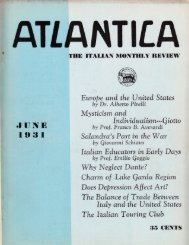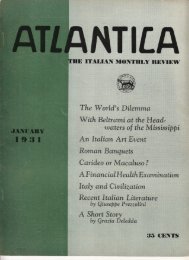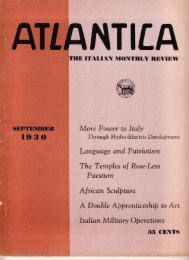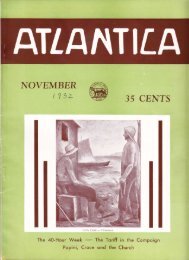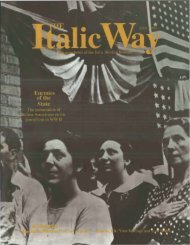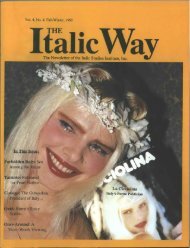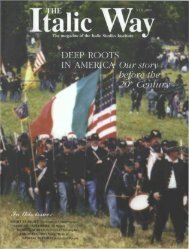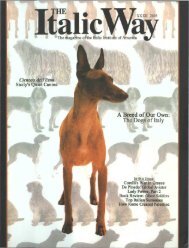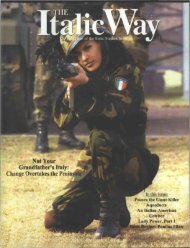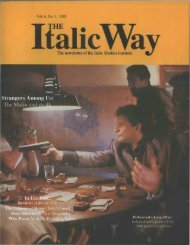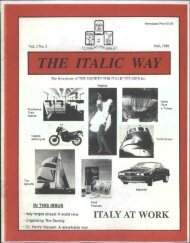$itt:lt:rlii,ililii56ing in conjunction with limitationb.v class. In this connectiona great deai of selectivepower has been placed in thehancls of the American consulsstationed abroad, because theclemancl fol r.isas is verr'- muchgreater than the number allotted.The process of picking ourimmigrants by hand, so tospeak, insteacl of by massmethods, has quite naturall.vimpror.ecl the character ofAmerican immigration. Goneare the nrasses of poor, unlearnedirninigrants, in sharvlsancl homespnl], carrYing theirhunlble bundles about in bervilderment.i+ ir. t3ftEPRESSI0N, ol eonrso,l'f l,u. afl'ectecl immigration,just as it has affectecl abouter.er)-thing else uncler the sun.Italians, Poles, Russians anclthe others, finiiing I'ork scarcein this country, are betakingthemselves Jrack to their homeland,where, eyen ifi the-v cannotfind uork, living is muchcheaper. lVhen the Lloyd $1fuaudoliner Conte Grancle sailetrthe otlier day with the bulk ofpassengers macle up of Italianfamilies, for example, it wasbut orie episode in the exodustliat is taking place these days.It is noteworthy to realtze,however, tirat in most cases thebreadlrinner, the head of thefamilv, renrains in this countrytill better times return.Colonel M. Serrati, interr.ierveclon that occasion, said:" The Italians are goodjuclges of the times. Of thesebookings ahnost every onemeans an entire family goingback to Itai,v, where they willwait for better times and avoiclwhat seems to them the approachof a desperate winterin Nel' York and surroundingcities."It is like the olcl da.vs ofRome, when Caesar's men hurriedtheir families ancl householdef{eets out of the countryat time of battle. There the oldATLANTICA, AUGUST-SEPTtrMBER, 1931Latin rvord 'impedimenta' rvasapplied to the exodus. Today,with a general exodus of ltalianfamilies to the comparativesafety of lower-priced ltal_r',we might call this the rlepar,ture of the 'impeclimenta.' InItal.v, in the countr5', these entirefamilies may live in greatcomfort for the equir,'alent of$25 a month." Think of what this meansto a man working harcl for aliving in this cit,v. He may supporthis familv in comfort andticle the family establishmentover a tense period for a sumless than he would pav ordinaril;.for rent here. "To the number of Italianswho are leaving because ofhard times, there must also beaddecl the not inconsiderablenumber who have made themodest fortunes thel- strovefol, and u{ro are going back totheir homeland to enjoy theirremaining days in quiet retire.ment, awa]. from the bustling,strenuous life of America.Tf1HERE is anotlrer side tor tlrp erodus of loreign na.tives from the tlnited States.This is the matter of " unwanted" or " r-Lndesirable "aliens who are being deportedinlarger and larger numberseverlr )-ear. During the fiscal-vear ending last J-une, for example,78,142 of these, man)'of them convicted felons, wereplacecl under arrest, taken tothe border or to a seaport, andsent back to the land whencethe-v came. The fig4ures for thethree fiscal )re&rs previous are:I928 -71,625; 7929- 12,908 ;and 1930-16,631. The nurnber,it can be seen, is growing greaterevery "vear.trYhile the theory behinclthese expulsions is laudable, itcannot be saicl that in practiceit is entirelv so, for it has beena subject of criticism for sometime. Even the WickershamCommission, in its tenth reportto the President, condemnedsome of the practices connecteclrvith it, finding that man--v personsare being separatecl permanentlvfrom their families inviolation of the "plainest dictatesof humanit,v, " throughthe r.ay some of the imniigrzttionlaws have been aclministereclrvithout either deviationor the simplest discretion.fncidentally, it must be high-}y srirprising to some who havepersisted in believing otherwise,to cliscover that, accordingto figures specialh- suppliedby the Bureau of Immigrationof the United States Departmentof Labor, Italians c1o notrank first, or even seconil, innumbers deportecl. In thecriminal classes, the_-v haveranked fourth, out of the eightnationalities listecl, for thepasl, three Years, and in the immoralclasses, the.v rank sirth(the last of the nationalitieslisted before the "All other"grouping).In any el'ent, the svstem ofalien cleportation is here,whether to stay or not \re cannotsa-r., or for how long, andl.hile it is in operation it is contributingits share tox.arcl diminishingthe number of foreignhornwlftes in this countrl-. Itis a part of the ebbing tide ofirrtnrigration'+ ,sis decleasrfMMIGRATION irrg rapidll', an,l thele arcnot man.r. rvho protest ol rriewwith alarm this great trirningpoint in the racial ccmpositionof America. The imrnigranthas played an inilispensablepart in the builiLing up of themachine age in the UnitedStates out of the raw materials,but now his cultain is comingdown. lVhether ol not therervil1 be neecl of more immigrationfor America in the futureis something no one can tell, yetit is strange that this sicle ofthe question should not havereceived the attention it de-SETVES.
HrIIIochs oItalian ArtLeonardo da Vinciand His ContemporariesBy Alfonso Arbib-CostaProfessor of ltalian at the College of the City of New yorkII.A T tle errel of tlre lifteerrtlr,Lt eerrtuLl', ItaJl- preserrts-/'- l- it rrrarvelous galarv of.:ninent zrrtists. At that timei-re art schools of the penin-:rila are constituted. Among:,re Tuscans, tr'ilippino Lippi: 'tnlrletes the chapei of theBrancacci; Cosimo Rosselli';r'orks at the Sistine Chapel,P,rllajolo and Sandro Botti-":elli bring forth with their,,rush those inimitable typesthose ingenious, fine ancl pro--rluncl expression impcses itselflike a cliscprieting ridcllerhich, after four centnries, still..irarms and perplexes us. Itis Leonarclo da \rinci l.ho wasto give these types their highestsignification, but SandroBotticelli (1447-1515) is alsoun€ of the most felicitous inr-enlorsof the Renaissance,hoth for the tender expressionn-hich dominates in liis r.irginsancl for the poetic phantasywhich is manifestecl rvith somnch superiority in his a}-legories of the Spring arrd ofCalumny; e\.en by the power,rf expression, as in the DeadChrist tliat is now at theJlunich Museum, and b_v thesentiment of great deoorationthat is found in his Moses inthe Sistine Chape}. Somecritics ciaim, however, that hecloes not possess the authorit_vof Domenico Bigordi, betterknorvn under the name of Ghi.rlandajo,l.ho was endowed withan imagination more powerfulthat Botticelli's, if less original,The lollowing article is thesecond ol a series of tour byProt. Arbib-Costa or,. greate,pochs ol Italian art. It followsthat in the preaious issueof ATLANTICA on "The Precursorsol the Renaissance:Giotto to lllasaccioo" and it uiillbe srrcceeded, by '(The Time,sof Michnel Angelo and, P.aphaelr"and 'oltalian Art i,n theSeaenteenth Century." Prol.Arbib-Costa here treats, but ind tnore extensiae wWt thesanne topics upon which he recen_tl,ydwelt in a series o!radio talhs oner StationVNYC lor the "Air Coll,ege',ol C.C.N.Y.and who was served besides b;'a rare surety of execution.Ghirlandajo is, indeed, theclassical master, the founderand head of a school. Hismasterpieces are to be seen ancladmired on the wall of theChurch of Santa Maria Novellain tr'l,rrence where, in his frescoes,on the lives of St. Johnthe Baptist and St. Francis ofAssisi he introduces l'ith arare dignity the portraits ofprominent tr'lorentine men andwomen of his time. The onlycontemporary- work that can57be corrparrecl to his is thatu..hich l-,uca Signorelli executedat Orvieto from 1499 to 1504.Those frescoes represent thescenes of the end of the x'orld:the Antichrist, the Resurrectionof the tr'lesh, the LastJudgment, and others. Signorelli,who livecl from 1441 to1523, is one of the greatest creatorsof forms that are to befound in the histor,v of painting.The originality of his lines,the porver of his composition,were to bc surpassed onl;. fu;.Michael Angelo, who himselfdeclares to have studiecl l-ithgreat attention the paintings ofOrvieto. J\-e can see Signoreilibesicle Ghir'lanclajo in tireChapel which Pope Sixtus I\'caused to be decoratecl b1' thegreatest artists of his time, anclperhaps of ali times, and whichtakes from that Pontiff thename of Sistine. \Ve har.e alreadyindicated the names ofBotticelli and Rosselli, whon'orked at the decoration of theChapel: u'e sha1l find there alsoPerugino.IETRO \-ANNUCCI, cal}etlPerugino from his natir.'ecity 61 Perugia, is the most remarkablerepresentatir.'e of theUmbrian School. -.\lthoughpreserving in most of his compositionsthe slightl). archaicsymmetry of his school, hebrings to his pictures a great
- Page 1 and 2: NTI LTtrB ITALIAiT MOITTIILY BEYIEW
- Page 3 and 4: tWHAT OTHtrRS THII\K OFOOATLAI\TTCA
- Page 5 and 6: illllq ill>TIC> r.eccrrrlv nrarlc.
- Page 7 and 8: ATT,ANTITAThe Italian Monthly Revie
- Page 9: The Turning T;de oflmmigrationBy Do
- Page 13 and 14: Xtrlrl* tt-nrleucr- of that periorl
- Page 15 and 16: From Mackinaw, Father.\fazzuchelli
- Page 17 and 18: -, l)l.0.luce caltcer|l, :- lol.in
- Page 19 and 20: FROI{ BUtrNOS AIRES TOPelu: extra p
- Page 21 and 22: l."{rr I talian-Amer ican E ducator
- Page 23 and 24: THE ITALiAN PHYSICIANS IN NEW YORK
- Page 25 and 26: mi-::s ll'oln the grouncl, irr- , :
- Page 27 and 28: he ltalian Pressr . - :ransferring
- Page 29 and 30: SELtrCTIONS FROM THE ITALIANPRESS 7
- Page 31 and 32: SELECTIONS FRO\,{ THE ITALIA\ PRESS
- Page 33 and 34: she was lost in dream. Amongthe tre
- Page 35 and 36: such despair and suffering thather
- Page 37 and 38: A Short StoryJim, the LoonBy Rosa Z
- Page 39 and 40: the bottles filled with that stufft
- Page 41 and 42: IT ,, tlie Editor of Atlantica:I am
- Page 43 and 44: TOPICS OF THE NIONTH89]. it recent
- Page 45 and 46: The ltalians in the l,lnited Stares
- Page 47 and 48: IOne of the features of the present
- Page 49 and 50: ATLA\TTICA IN BREVE95CANCERby Dr. A
- Page 51 and 52: AI\ EXECT]TIVETRAII\II\G PLAI\fn, m



